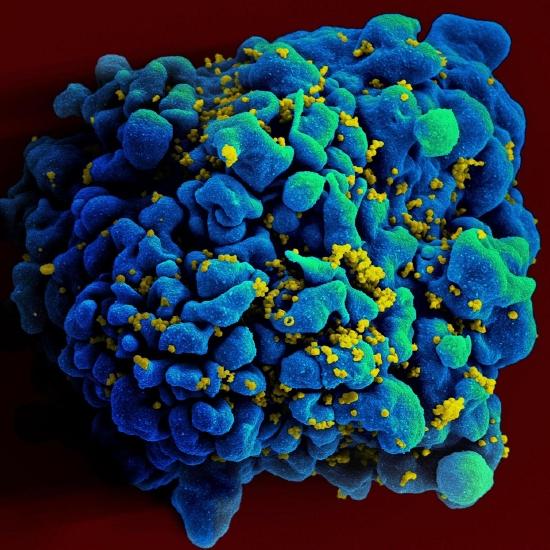纽约一名感染艾滋病毒(HIV)且患有急性髓系白血病(AML)的女性在接受了来自对HIV具有自然抵抗力供体的干细胞移植后,成为迄今为止全球第一位女性和第三位治愈艾滋病的人。

New York patient becomes the first woman to possibly be cured of HIV
A third person has been cured of HIV through an umbilical cord stem cell transplant, a new method of treatment.
一名艾滋病患者通过脐带干细胞移植治愈了艾滋病,这是第三位通过这种新疗法治愈的病人。
The patient, a mixed-race woman, is now in remission after being diagnosed with the virus in 2013. The previous patients — two men named Timothy Ray Brown and Adam Castillejo — were curved of HIV through bone marrow or adult stem cell transplant.
这名患者是一名混血女性,2013 年被诊断出感染艾滋病毒。此前的两例成功被治愈的艾滋病患者——名叫蒂莫西·雷·布朗(Timothy Ray Brown)和亚当·卡斯蒂列霍(Adam Castillejo)的男性——通过骨髓或成体干细胞移植治愈了艾滋病。
The "New York patient," as she's being called, had been diagnosed with leukemia as well as HIV, and was given cord blood to help treat her cancer. The cord blood came from a partially matched donor, and the woman also was given blood from a relative so her body would have "temporary immune defenses" during the transplant process.
这名被称为“纽约病人”的女性患者被诊断出感染艾滋病毒且患有白血病,她接受了脐带血移植以帮助治疗她的癌症。用于移植的脐带血来自一位部分匹配的捐献者,这名女性患者还还接受了来自直系亲属的血液移植,目的是使她的身体在移植过程中具有“暂时的免疫防御”。
While both men, who were the first two patients to be cured of HIV, received bone marrow transplants to treat the virus, the woman's case marks a new method in the fight against HIV.
虽然之前的两名男性是最早治愈艾滋病的患者,但他们都是通过接受骨髓移植来治疗病毒,而这名女性病例的治愈标志着抗击艾滋病毒又有了新方法。

Brown and Castillejo both received bone marrow transplants from donors whose marrow contained an HIV-blocking mutation. Such mutation is rare and often found in donors of Northern European descent.
布朗和卡斯蒂列霍都接受了来自携带阻断HIV感染突变的供体骨髓移植。这种突变很少见,而且通常出现在北欧血统的捐赠者中。
Although the bone marrow transplant proved successful in both cases, it did not come without consequences for the men; Brown almost died after the procedure and Castillejo lost a significant amount of weight, developed hearing loss and suffered infections.
尽管骨髓移植在这两个男性病例中都证明是成功的,但这两名患者付出了沉重的代价。手术后布朗差点死去,卡斯蒂列霍体重大幅下降,出现听力损失和感染。
The woman who was cured through stem cells left the hospital 17 days later and did not develop graft versus host disease, a condition both Brown and Castillejo suffered from following their bone marrow transplants.
这名通过干细胞移植治愈的女性在 17 天后出院,并没有患上布朗和卡斯蒂列霍在骨髓移植后都出现的移植物抗宿主病。
The woman received her transplant in 2017, and stopped taking HIV medicine three years later. Fourteen months after stopping antiretroviral therapy, she had "no detectable virus".
这名女性于 2017 年接受了移植手术,三年后停止服用 HIV 药物。在停止抗逆转录病毒(ART)治疗 14 个月后,她“没有检测到病毒”。
The woman had been participating in a study that monitored 25 HIV positive patients in the U.S. who underwent a transplant.
该患者一直在参与一项研究,研究目的是监测美国 25 名接受移植的 HIV 阳性患者的疾病发展情况。
UCLA infectious disease physician Dr. Yvonne Bryson, who led the study that the woman took part in, addressed her case at the Conference on Retroviruses and Opportunistic Infections this week.
美国加州大学洛杉矶分校 (UCLA)传染病医师 伊冯娜·布莱森(Yvonne Bryson) 博士领导了该名女性患者的这项治疗研究,她在本周的逆转录病毒和机会性感染会议上讨论了这一病例。
"Today, we reported the third known case of HIV remission and the first woman following a stem cell transplant and using HIV-resistant cells," Bryson said in a press conference.
“今天,我们报告了第三例已知的 HIV 感染者治愈的病例,也是第一位接受干细胞移植并使用抗 HIV 细胞的女性,”布莱森在新闻发布会上说。
"This case is special for several reasons: First, our participant was a U.S. woman living with HIV of mixed race, who needed a stem cell transplant for treatment of her leukemia," she continued. "And she would find a more difficult time finding both a genetic match and one with the HIV-resistant mutation to both cure her cancer and potentially her HIV. This is a natural, but rare mutation."
“这个案例之所以特殊,有几个原因:首先,我们的参与者是一名美国混血感染艾滋病毒的女性,她需要进行干细胞移植来治疗她的白血病,”她继续说道,“而且她会发现更难找到基因匹配和具有 HIV 抗性突变的基因匹配来治愈她的癌症和潜在的 HIV病毒。这是一种自然但罕见的突变。”
Despite the success of the woman's case, researchers caution that the treatment used to cure her HIV is not a widely applicable method.
尽管该女性的案例取得了成功,但研究人员警告说,用于治愈她的艾滋病毒的治疗方法并不是一种广泛适用的方法。
Dr. Anthony Fauci told Community Health Center, "I don't want people to think that now this is something that can be applied to the 36 million people [globally] who are living with HIV. "
安东尼·福奇(Anthony Fauci) 博士告诉社区健康中心:“我并不希望人们认为现在这可以将这种治疗方法应用于全球3600万艾滋病毒感染者”。
Fauci added, "This person had an underlying disease that required a stem cell transplant. ... It is not practical to think that this is something that's going to be widely available. It's more of a proof of concept."
福奇补充说:“这名患者患有需要干细胞移植的潜在疾病。......认为这将是广泛可用的东西是不切实际的。这更像是一个概念证明。”

